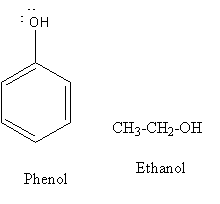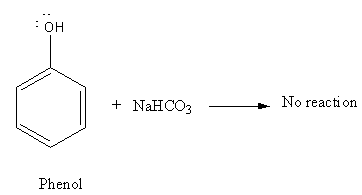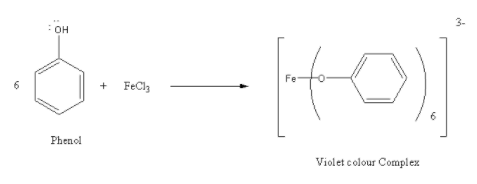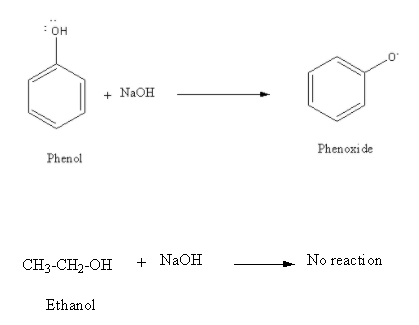
Answer
401.4k+ views
Hint:Determine whether phenol and ethanol are acidic, basic or neutral in nature. Red litmus paper turns to blue in the basic medium. In presence of acid \[{\text{NaHC}}{{\text{O}}_{\text{3}}}\] dissociate and liberate \[{\text{C}}{{\text{O}}_{\text{2}}}\]gas. Write the reaction of phenol and ethanol with \[{\text{FeC}}{{\text{l}}_{\text{3}}}\] and \[{\text{NaOH}}\] and determine if there is any colour change.
Complete step-by-step answer:
The structure of phenol and ethanol are as follows:

Now using chemical properties of phenol and alcohol we will decide the distinguishing test for phenol and ethanol.
A) Red litmus paper : Litmus paper is used to distinguish acid from the base. Red litmus paper turns to blue in basic medium while remaining unchanged in acidic medium. Phenol is acidic in nature while ethanol is a very weak acid. It is almost neutral. So red litmus paper will remain unchanged in both phenol and ethanol so it cannot be used to distinguish Phenol and ethanol. Thus, option (A) is an incorrect answer.
B)\[{\text{NaHC}}{{\text{O}}_{\text{3}}}\] : Sodium bicarbonate (\[{\text{NaHC}}{{\text{O}}_{\text{3}}}\]) is a weak base in presence of acid it dissociates into \[{\text{C}}{{\text{O}}_{\text{2}}}\]gas and water.
\[{\text{NaHC}}{{\text{O}}_{\text{3}}}{\text{ + H + }} \to {\text{C}}{{\text{O}}_{\text{2}}} + {{\text{H}}_{\text{2}}}{\text{O}}\]
Though phenol is acidic in nature it is very weak acid so it will not react with Sodium bicarbonate,\[{\text{NaHC}}{{\text{O}}_{\text{3}}}\].

As ethanol is neutral in nature it will not react with Sodium bicarbonate,\[{\text{NaHC}}{{\text{O}}_{\text{3}}}\].

So, there will be no reaction of \[{\text{NaHC}}{{\text{O}}_{\text{3}}}\] with phenol and ethanol. Thus, option (B) is an incorrect answer.
C) \[{\text{FeC}}{{\text{l}}_{\text{3}}}\] : Addition of \[{\text{FeC}}{{\text{l}}_{\text{3}}}\] in phenol gives a violet colour complex. While addition \[{\text{FeC}}{{\text{l}}_{\text{3}}}\] to phenol does not show any colour change. So, \[{\text{FeC}}{{\text{l}}_{\text{3}}}\] is used to distinguish phenol from ethanol. Thus, the correct option is (C) \[{\text{FeC}}{{\text{l}}_{\text{3}}}\].

D) \[{\text{NaOH}}\] : Sodium hydroxide,\[{\text{NaOH}}\] is a strong base so it reacts with acidic phenol and gives phenoxide. However, since ethanol is neutral in nature it does not react with \[{\text{NaOH}}\].

Though phenol reacts with \[{\text{NaOH}}\] but it does not show any colour change so \[{\text{NaOH}}\] can not be used to distinguish phenol from ethanol. Thus, option (D) is an incorrect answer.
Hence the correct answer is option ‘C’.
Note:To distinguish two different colourless species we have to carry out chemical reactions. We have to select the reagent that shows colour change after reacting with one species and remain unchanged after addition in another species. Litmus test can be used only if one species is acidic in nature and another species is basic in nature.
Complete step-by-step answer:
The structure of phenol and ethanol are as follows:

Now using chemical properties of phenol and alcohol we will decide the distinguishing test for phenol and ethanol.
A) Red litmus paper : Litmus paper is used to distinguish acid from the base. Red litmus paper turns to blue in basic medium while remaining unchanged in acidic medium. Phenol is acidic in nature while ethanol is a very weak acid. It is almost neutral. So red litmus paper will remain unchanged in both phenol and ethanol so it cannot be used to distinguish Phenol and ethanol. Thus, option (A) is an incorrect answer.
B)\[{\text{NaHC}}{{\text{O}}_{\text{3}}}\] : Sodium bicarbonate (\[{\text{NaHC}}{{\text{O}}_{\text{3}}}\]) is a weak base in presence of acid it dissociates into \[{\text{C}}{{\text{O}}_{\text{2}}}\]gas and water.
\[{\text{NaHC}}{{\text{O}}_{\text{3}}}{\text{ + H + }} \to {\text{C}}{{\text{O}}_{\text{2}}} + {{\text{H}}_{\text{2}}}{\text{O}}\]
Though phenol is acidic in nature it is very weak acid so it will not react with Sodium bicarbonate,\[{\text{NaHC}}{{\text{O}}_{\text{3}}}\].

As ethanol is neutral in nature it will not react with Sodium bicarbonate,\[{\text{NaHC}}{{\text{O}}_{\text{3}}}\].

So, there will be no reaction of \[{\text{NaHC}}{{\text{O}}_{\text{3}}}\] with phenol and ethanol. Thus, option (B) is an incorrect answer.
C) \[{\text{FeC}}{{\text{l}}_{\text{3}}}\] : Addition of \[{\text{FeC}}{{\text{l}}_{\text{3}}}\] in phenol gives a violet colour complex. While addition \[{\text{FeC}}{{\text{l}}_{\text{3}}}\] to phenol does not show any colour change. So, \[{\text{FeC}}{{\text{l}}_{\text{3}}}\] is used to distinguish phenol from ethanol. Thus, the correct option is (C) \[{\text{FeC}}{{\text{l}}_{\text{3}}}\].

D) \[{\text{NaOH}}\] : Sodium hydroxide,\[{\text{NaOH}}\] is a strong base so it reacts with acidic phenol and gives phenoxide. However, since ethanol is neutral in nature it does not react with \[{\text{NaOH}}\].

Though phenol reacts with \[{\text{NaOH}}\] but it does not show any colour change so \[{\text{NaOH}}\] can not be used to distinguish phenol from ethanol. Thus, option (D) is an incorrect answer.
Hence the correct answer is option ‘C’.
Note:To distinguish two different colourless species we have to carry out chemical reactions. We have to select the reagent that shows colour change after reacting with one species and remain unchanged after addition in another species. Litmus test can be used only if one species is acidic in nature and another species is basic in nature.
Recently Updated Pages
Fill in the blanks with suitable prepositions Break class 10 english CBSE

Fill in the blanks with suitable articles Tribune is class 10 english CBSE

Rearrange the following words and phrases to form a class 10 english CBSE

Select the opposite of the given word Permit aGive class 10 english CBSE

Fill in the blank with the most appropriate option class 10 english CBSE

Some places have oneline notices Which option is a class 10 english CBSE

Trending doubts
Fill the blanks with the suitable prepositions 1 The class 9 english CBSE

How do you graph the function fx 4x class 9 maths CBSE

Which are the Top 10 Largest Countries of the World?

What is the definite integral of zero a constant b class 12 maths CBSE

Who was the Governor general of India at the time of class 11 social science CBSE

Distinguish between the following Ferrous and nonferrous class 9 social science CBSE

Name five important trees found in the tropical evergreen class 10 social studies CBSE

The Equation xxx + 2 is Satisfied when x is Equal to Class 10 Maths

Differentiate between homogeneous and heterogeneous class 12 chemistry CBSE




